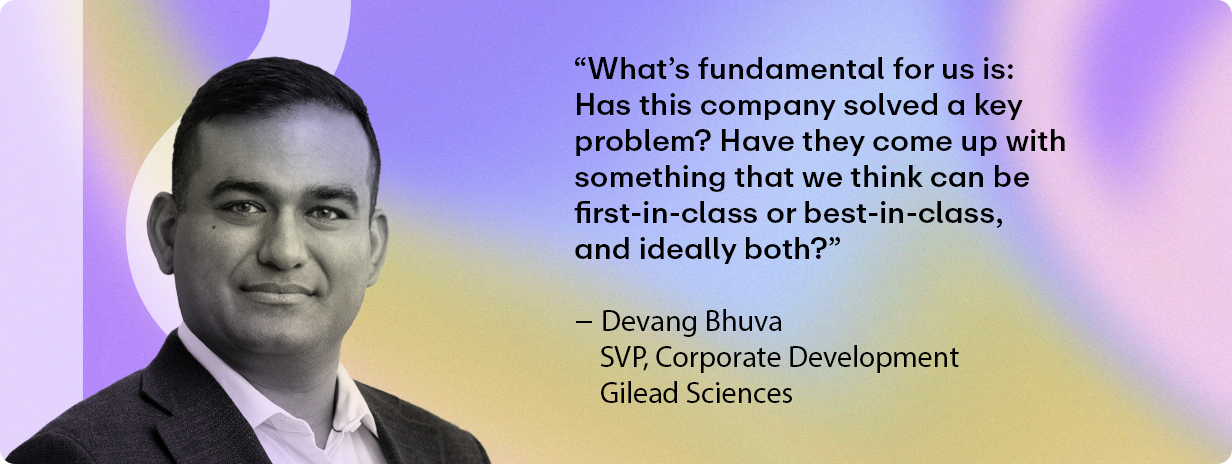Gilead Sciences SVP, corporate development Devang Bhuva arrived at the company five years ago from the financial world, where he’d spent the first decade-plus of his career working across a range of clients and industries. Now established as one of Gilead’s primary development execs, he has moved aggressively to add assets that bolster the organization’s presence in virology, oncology and inflammation.
In this excerpt from his podcast conversation with Kinara co-editor Chase Feiger, Bhuva offers a primer on high-level M&A in pharma. He shares the approaches that have fueled Gilead’s recent deal-making, emphasizing the role of cultural alignment as well as the need for flexibility in post-acquisition integration.
(This Q&A has been edited for length and clarity. To listen to the full Kinara podcast with Devang Bhuva, click here.)
Chase Feiger: What distinguishes Gilead’s approach to business development and M&A?
Devang Bhuva: When you look at Gilead’s history, so much of it has been built upon external innovation—our early antivirals from the acquisition of Triangle Pharma really created the foundations for what became our HIV franchise. Then when you look at what we’ve done to cure hepatitis C, a huge portion of it was due to acquiring a company called Pharmasett that started the backbone of our first therapy for hepatitis C and allowed us to continue innovating on top of it. What differentiates us today, I think, is that Gilead has this mindset that there’s one Gilead portfolio. It doesn’t matter if something came from internal research or from external innovation; we’ll have the same mindset toward developing it to its fullest potential.
I would also say that we’re relatively small compared to companies of our revenue or market cap or R&D budget. We’re able to be very nimble and flexible in our approach, and that’s required if you want to attract the best innovators to Gilead and the best innovators to partner with..
Feiger: You have a rare mix of finance strategy and operational experience. How do you stay close to the science while keeping a high-level lens on long-term decisions?
Bhuva: It’s probably the most fun part of the job, to be honest. One of the reasons I came to Gilead and left a career in investment banking is to get much closer to the science. As an outside advisor to companies, you’re working with boards, CEOs, CFOs and heads of business development, but you’re not necessarily all that close to the science. The greatest part about being here is sitting with our research, development and manufacturing colleagues, and seeing how we actually create these special molecules for patients. Being deep in the diligence of assessing the internal and external programs is a core part of the job.
Feiger: There are a lot of biotech companies that would love to get corporate development or acquisition interest from an organization like Gilead and they’re excited to learn a little bit about how the typical deal cycle works. What does the arc usually look like when you’re evaluating these opportunities?
Bhuva: There’s no one way that it happens, or a typical timeline or process it follows. We pride ourselves on being agile and nimble and flexible in how we approach getting deals done. There have been times when we went from a first meeting with a company to getting a deal done within a matter of weeks. There have been other times where we monitored the progress of a company for years before we actually engaged on the business-development side.
What’s fundamental for us is: Has this company solved a key problem? Have they come up with something that we think can be first-in-class or best-in-class, and ideally both? We’re looking for that level of innovation and what we bring to the table is a phenomenal research and development organization that has been working on these products for years and years.
Feiger: When you’re weighing a potential acquisition, how do you strike the right balance between scientific promise, financial return and even cultural alignment?
Bhuva: It almost always starts with the science. It has to. And that can come in different forms, whether it’s a modality approach or whether it’s a new target that somebody’s going after. But at the end of the day, it needs to benefit patients in a way that’s much more efficacious and much safer than what’s out there. It has to be much more convenient for patients than what’s out there. So there’s different levels of how you get to that differentiation, but it needs to happen and generally that is driven by the science.
You raise a great point about the culture piece. I’ve learned this personally as a former banker and now at Gilead, where we’ve acquired companies and done great partnerships. That cultural piece is oftentimes one of the most critical elements to whether a collaboration or an acquisition will work. It’s something that we spend more and more time on early on in a deal process: Can we actually work with these people? Will the cultures of the organization mesh in such a way that the best science will come out of it? Or is there too much territorialism or too much pride between the organizations where it actually will stifle innovation?
Feiger: Does competitive tension ever influence your timeline or decision making?
Bhuva: Absolutely. We love to believe that we are first at the table and that we’ve seen all the innovation before any of our competitors. Quite frankly, that’s not always the case. We get calls all the time from venture capitalists or investors or bankers saying, “Hey, this company that you guys have been meeting with for six months now has a proposal from somebody else.” In those situations where we were otherwise taking a more pragmatic approach to a deal, we’ll rally the troops and come to the table and say, “Okay, we thought we were going to solve this issue within a couple months. We need to solve it in a couple weeks.” What we try to do is make sure it doesn’t change our fundamental decision-making, that it doesn’t change our bar for innovation and what’s going to matter for patients.
Feiger: With so much noise across the ecosystem—you’re getting calls from VCs and from bankers, you’re getting inbounds from CEOs of biotechs—how do you find the signal within the noise? What helps you stay focused on the right opportunities?
Bhuva: It’s not easy. It’s nearly impossible to stay on top of every company, even just within the therapeutic areas that we play in. We know what we are looking for and the targets we want to go after, and we focus 90% of our time on them so that we can be best positioned to pursue those opportunities. Because otherwise you can get so distracted by everything else happening out there.
The other element right now is that, with the challenging markets and the turbulent macroeconomic environment, there’s so much volatility in our sector that you want to stay grounded. But at the same time, you need to be nimble when there are opportunities that otherwise wouldn’t present themselves. You need to be flexible in how you approach them.
Feiger: Once a deal closes, how do you think about the integration process? Do you lean toward preserving a team’s independence or toward integrating it quickly in the Gilead ecosystem?
Bhuva: This is probably the biggest learning that I’ve had since joining Gilead. As a banker, the job was done once the deal was closed. You weren’t necessarily focused on anything that happened after closing. But here, you’re going to live for the next decade-plus with the product, the team and the portfolio. So it’s about taking a bespoke approach to integrating them.
There are lots of factors that play into it. What are the capabilities that Gilead has versus the capabilities the other company has? Three years ago we acquired MiroBio, which was based in Oxford, England. Gilead has historically had all research based here in California, but we found that these people had incredible expertise and knowledge around checkpoint agonism. It was a phenomenally strong team, so we took the approach of leaving them in place for the foreseeable future. That’s a fundamental part of the overall deal process: What are we going to do after we own the asset? How are we going to maximize what we can get out of this?
Feiger: Some potential acquisitions are going to happen spontaneously, but others you might proactively be looking for given where certain products are in the drug development cycle. Is there an opportunity to partner with biotech CEOs who have successfully built companies in the past?
Bhuva: It’s something that we’ve done before and consider often. To evaluate a program we rely on our internal expertise, but we don’t have that expertise in every field. So there might be a great CEO entrepreneur who’s developing a modality that could be really transformational. There’s a lot of risk, because there’s a lot of capital that needs to go into it.
Gilead absorbing that from day one probably wouldn’t make the innovation flourish in the best possible way. And so there are situations where oftentimes we will be a sort of proactive partner and invest behind a company—maybe have a person sit on their scientific advisory board or their board of directors—to help provide a perspective and guide where the company goes, but not take a hands-on approach to controlling what they do. That allows us to stay incredibly close to the science and the development, so that maybe there is a partnership or an acquisition down the road. It allows us to one, become educated and two, guide the science based on the expertise we can provide without being overly controlling or inadvertently stifling the innovation or entrepreneurial spirit of the company.




